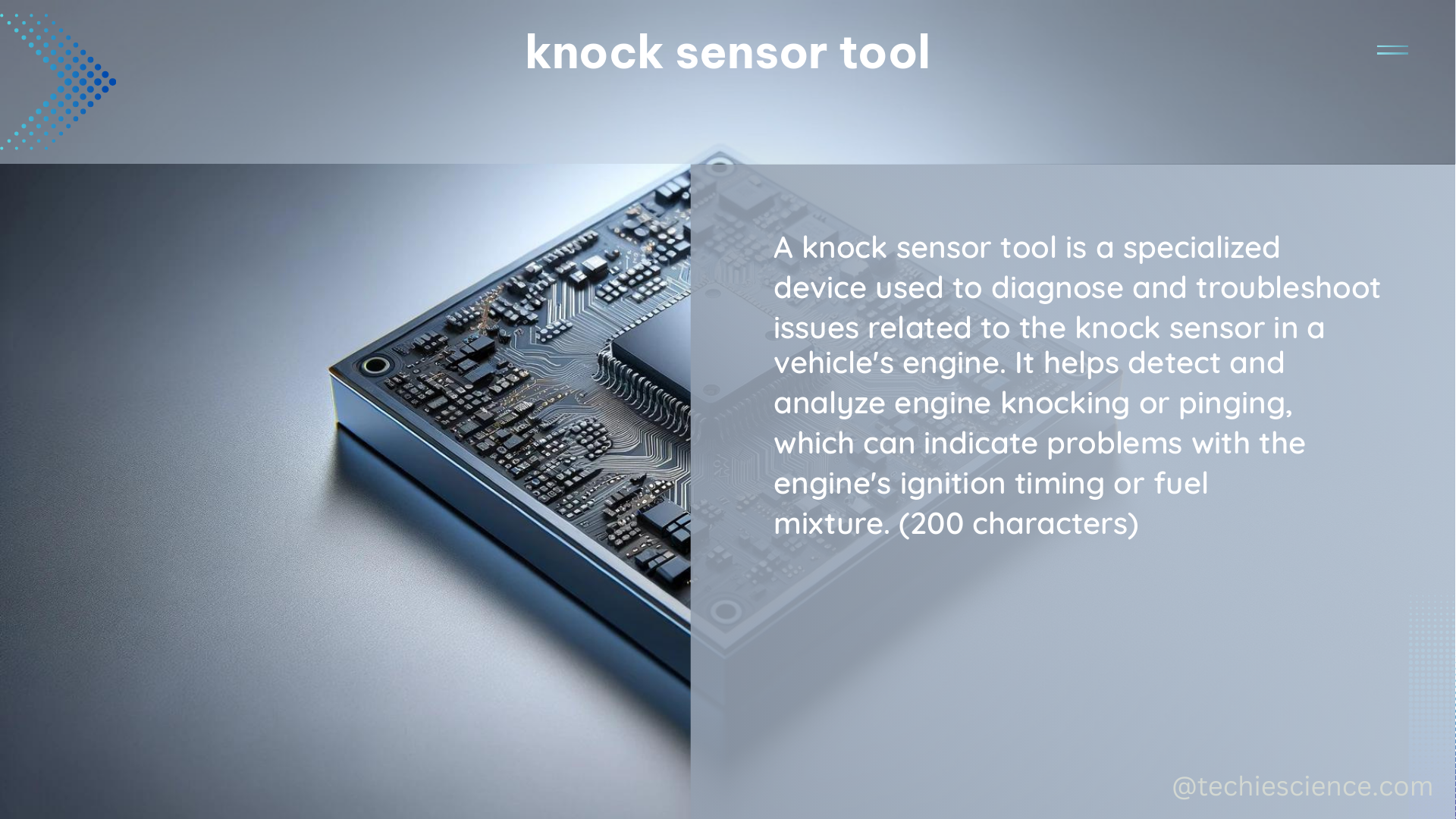The knock sensor tool is a crucial component in modern engines, designed to detect knocking or detonation in the combustion chamber. Knocking is an abnormal combustion phenomenon that can lead to engine damage if not addressed promptly. The knock sensor tool measures the vibrations produced by knocking and transmits this data to the engine control unit (ECU), which then adjusts the ignition timing to prevent further knocking, protecting the engine from potential damage.
Technical Specifications of Knock Sensor Tool
-
Sensitivity: Knock sensors typically have a sensitivity range of 5 to 50 mV/g, where g is the unit of acceleration due to gravity. This sensitivity determines the sensor’s ability to detect knocking vibrations. The higher the sensitivity, the more accurate the sensor will be in detecting even the slightest vibrations caused by knocking.
-
Frequency Response: Knock sensors should have a flat frequency response in the range of 5 to 15 kHz, which covers the typical frequency range of knocking vibrations. This ensures that the sensor can accurately capture the full spectrum of vibrations associated with knocking, allowing the ECU to make precise adjustments.
-
Operating Temperature: Knock sensors are designed to operate in a wide temperature range, typically from -40°C to 150°C, to ensure reliable operation in various engine conditions. This wide temperature tolerance is crucial, as engines can experience significant temperature fluctuations during operation, and the knock sensor must be able to function accurately in all these conditions.
-
Mounting: Knock sensors are usually mounted on the engine block or cylinder head, close to the combustion chamber, to ensure accurate detection of knocking vibrations. The proximity of the sensor to the source of the vibrations is essential for capturing the most accurate data.
-
Durability: Knock sensors are designed to withstand the harsh environment of the engine compartment, including exposure to vibrations, shocks, and various fluids. They are typically made of durable materials, such as stainless steel or high-performance plastics, to ensure long-lasting performance.
-
Electrical Characteristics: Knock sensors typically have a resistance of around 1 to 10 kΩ and operate on a voltage range of 5 to 12 V. The sensor’s output signal is usually in the range of 5 to 50 mV, which the ECU can then interpret to detect knocking.
-
Connector Type: Knock sensors often use a standardized connector type, such as a Bosch-style or Delphi-style connector, to ensure compatibility with the vehicle’s wiring harness and ease of replacement.
-
Calibration: Knock sensors may require calibration during installation or replacement to ensure accurate detection of knocking vibrations. This calibration process is typically performed by the vehicle’s ECU or a specialized diagnostic tool.
DIY Tips for Knock Sensor Tool

-
Testing Knock Sensor: To test a knock sensor, you can use a labscope or back-probing tools to monitor the sensor’s output signal while the engine is running. A healthy knock sensor should produce a clean, stable signal, with a voltage range of approximately 5 to 50 mV. If the signal is excessively noisy or shows no output, it may indicate a faulty sensor.
-
Checking Continuity: You can check the continuity between the knock sensor and the ECU using a multimeter. Disconnect the sensor from the wiring harness and measure the resistance between the sensor’s terminals and the corresponding pins on the ECU connector. A continuous path with the expected resistance range (typically 1 to 10 kΩ) indicates a good connection, while an open circuit suggests a faulty connection or a damaged sensor.
-
Inspecting Visually: Visually inspect the knock sensor for any signs of damage, such as cracks, corrosion, or mechanical wear. Check the sensor’s mounting location and ensure that it is securely attached to the engine block or cylinder head. A damaged sensor should be replaced to ensure reliable operation.
-
Replacement Procedure: When replacing a knock sensor, ensure that the new sensor is compatible with your vehicle’s make, model, and year. Follow the manufacturer’s instructions for proper installation, including the recommended torque specifications for the mounting bolt. After installation, clear any diagnostic trouble codes related to the knock sensor and perform a test drive to verify proper operation.
-
Diagnostic Codes: If the vehicle’s ECU detects an issue with the knock sensor, it will set a diagnostic trouble code (DTC). Common knock sensor-related DTCs include P0325 (knock sensor circuit malfunction) and P0326 (knock sensor circuit range/performance problem). Refer to your vehicle’s service manual or a diagnostic tool to interpret these codes and troubleshoot the issue.
-
Preventive Maintenance: Regular inspection and maintenance of the knock sensor can help ensure its long-term reliability. Check the sensor’s wiring and connections for any signs of wear or damage, and replace the sensor if it shows signs of deterioration or if the vehicle’s diagnostic system indicates a problem.
By understanding the technical specifications and following these DIY tips, you can effectively diagnose, maintain, and troubleshoot the knock sensor tool in your vehicle, ensuring optimal engine performance and protection.
References:
- SVT Performance Forum – Knock Sensor Reading Question from My Data Logs
- YouTube – How to Test a Knock Sensor
- Rennlist Forum – Archaelogical Dig Finds Knock Sensor in Worst Shape of All Time
- Bosch Automotive Handbook – Knock Sensor
- NGK Spark Plugs – Understanding Knock Sensors

The lambdageeks.com Core SME Team is a group of experienced subject matter experts from diverse scientific and technical fields including Physics, Chemistry, Technology,Electronics & Electrical Engineering, Automotive, Mechanical Engineering. Our team collaborates to create high-quality, well-researched articles on a wide range of science and technology topics for the lambdageeks.com website.
All Our Senior SME are having more than 7 Years of experience in the respective fields . They are either Working Industry Professionals or assocaited With different Universities. Refer Our Authors Page to get to know About our Core SMEs.